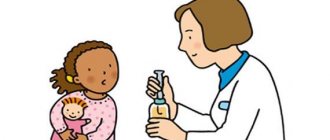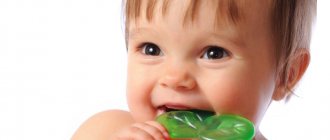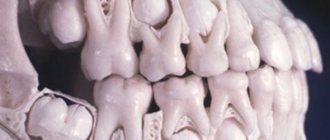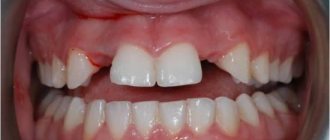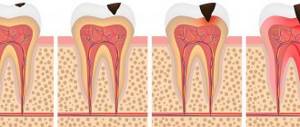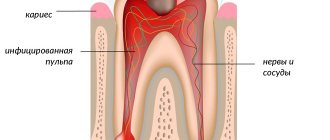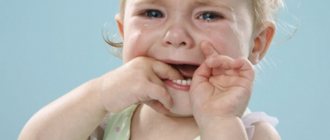Teething
The criteria for physiological teething are certain timing, a certain order and pairing (the simultaneous appearance of teeth of the same name in the right and left half of the jaw).
Newborns have no teeth in the oral cavity; the mucous membrane covers the edge of the alveolar process, forming a dense cushion. However, the process of developing teeth begins already at the 6-8th week of embryogenesis. By the time of birth, each child’s jaw already contains 10 temporary and 8 permanent follicles (tooth buds), which are at different stages of development and mineralization. The remaining rudiments of permanent teeth are formed in the jaws after birth.
On average, the eruption of baby teeth in children begins at the age of 6-7 months, when the formation of the tooth crown ends and its root begins to develop. The first to appear in the oral cavity are the lower central incisors, then (at 8-9 months) the upper central incisors. The eruption of the upper lateral incisors occurs in a child at 9-11 months; lower lateral – at 11-13 months. Then, at about 1-1.5 years, the first upper molars (molars) appear, followed by the first lower molars. Then the canines sequentially erupt on the upper and lower jaws (at 16-20 and 17-22 months, respectively). The eruption of primary teeth ends at the age of 2-2.5 years with the appearance of the second lower and upper molars.
Thus, the primary occlusion in children has 20 teeth; There are no premolars in it. In pediatrics, to roughly estimate the number of teeth in a child under one year old, the formula is used: N - 4, where N is age in months. The timing of teething in normally developing children may shift in one direction or another: for example, some have milk teeth at the age of 4 months. – 2 years; for others - from 8-10 months. up to 3.5 years.
Immediately after eruption, baby teeth have porous and rough enamel, which contains few microelements. Therefore, if proper dental hygiene, diet, and dental prophylaxis are not observed (fissure sealing, application of fluoride-containing medications, deep fluoridation), there is a high risk of developing caries in primary teeth. The consequence of intrauterine underdevelopment of tooth tissue can be enamel hypoplasia.
The timing of the eruption of permanent teeth usually coincides with the timing of the loss of milk teeth. As a rule, already after the loss of a temporary tooth, tubercles or part of the cutting edge of a permanent tooth are visible in the socket. The eruption of permanent teeth begins with the first molars at the age of 5-6 years. Permanent central incisors (lower, then upper) appear at 6-8 years of age; behind them, at 8-10 years, the lateral incisors change. The eruption of canines, first and second premolars (small molars) occurs at the age of 10-12 years. The second molars are the last ones to erupt by the age of 13-14. By the age of 17-25, wisdom teeth appear (sometimes they do not erupt at all).
Children's permanent teeth differ significantly from adult teeth in their anatomical features. In particular, in permanent teeth in children, the volume of the tooth cavity and pulp is much larger, and the amount of hard tissue is smaller, so various exogenous factors can easily cause caries and pulpitis. That is why it is so important to provide proper care from the very beginning, regularly undergo professional hygiene, and treat teeth with fluoride preparations.
Impaired development and eruption of teeth
The main deviations in the development and eruption of teeth include adentia and retention. Adentia (lack of teeth) An already formed jaw may be missing one or more teeth. In such cases they speak of partial edentia. If all teeth are missing (this is very rare), then this is complete edentia.
An X-ray examination must be carried out in all cases of missing teeth to determine whether the rudiments of primary and permanent teeth are present. If they are present, it is determined whether there are any local reasons leading to a delay in tooth eruption (supernumerary teeth, etc.). Supernumerary teeth are often located in the anterior parts of the jaw, mainly in the mixed and permanent dentition. Less common are supernumerary molars located behind the third molars.
The cause of edentia is a violation of the formation of tooth germs in intrauterine life under the influence of various internal and external factors.
Retention (non-eruption of teeth) By retention we mean a delay in the eruption of a normally formed tooth. The most common case is retention of the maxillary canines. The cause of retention may be the premature removal of the fang of a milk tooth and the filling of the vacated hole in the jaw not with a permanent fang, but with an adjacent permanent tooth, for example, the first small molar, which, as a rule, erupts somewhat earlier than the canine. Retention is also possible as a result of incorrect position of the developing permanent tooth in the jaw. In this case, the corresponding milk tooth does not fall out for a long time and remains in the same row as the erupted permanent teeth. Impacted teeth can cause attacks of neuralgic pain in the facial area, which arise due to tooth pressure on one or another branch of the nerve, as well as inflammatory processes in the jaws and surrounding tissues.
In some cases, you can encounter early teething, when a child is born with already erupted milk teeth. Most often these teeth are the central incisors.
Cases of late eruption are much more common. This usually refers to the eruption of a third of their molars (wisdom teeth).
The timing of the eruption of primary and permanent teeth, depending on the general condition of the child, may shift in one direction or another. There are premature (early) and delayed teething.
1. Premature teething should be explained by the individual characteristics of the person. Often, teeth that erupt early are more easily susceptible to caries. 2. Delayed teething.
Causes of delayed teething: - rickets and other disorders of calcium-phosphorus metabolism; - decreased activity of the endocrine glands (hypothyroidism); - disturbances in the digestion and absorption of nutrients; - severe nutritional disorders; - chronic infections; — hereditary disorders of mineral metabolism and diseases of osteochondral tissue; - a family trait.
A. Premature removal of baby teeth negatively affects the process of development and eruption of permanent teeth. Complications in the eruption of permanent teeth after premature loss of milk teeth also come down to the displacement of already erupted teeth and to a decrease in space for the corresponding tooth. This circumstance can complicate and delay the eruption of permanent teeth.
B. Incorrect position of the tooth germ is one of the common causes of delayed eruption. Incorrect position of the tooth can be to a slightly pronounced degree, starting from a slight tilt to a transverse position and ending with the eruption of teeth in the nasal cavity, on the palate (in rare cases). If the position of a permanent tooth is incorrect, its predecessor—the baby tooth—does not fall out in a timely manner, since the root of the tooth is not resorbed.
B. Supernumerary teeth not only interfere with the proper placement of the teeth, but can also interfere with their eruption.
D. Follicular cysts delay the eruption of teeth if surgical intervention is not provided. In all cases of delayed tooth eruption, it is necessary to find out the cause using x-rays.
Teething pattern The child will eventually have 20 primary teeth, 10 on each jaw, but all of them will gradually erupt until about two years of age.
We are now more interested in the order in which the first of them erupt, that is, in a baby up to a year old. The first milk teeth appear at 6-8 months. Usually the order of cutting is as follows.
Between 6 and 8 months of life, the central incisors of the lower jaw appear, which are located in the very center of the lower jaw.
Then the central upper incisors appear, which are also located in the center of the dentition.
By 8-12 months - the upper lateral incisors, located next to the central ones.
Then the same teeth appear on the lower jaw.
Usually, by the age of one year, a child should normally have 8 teeth, but parents should know that the presence of 2-4 or the presence of 10 teeth at this age is not a serious deviation. Too early or late appearance of teeth can be determined by heredity. You can only worry if the child’s teeth have not appeared before the age of one. In this case, consultation with a pediatric dentist is necessary. Doctors sometimes take x-rays to determine the condition of unerupted teeth.
Eruption of baby teeth. Symptoms.
Teething in children is not a disease, but a natural physiological process. It can be accompanied by different symptoms in different children.
Typical symptoms of teething:
- Swollen gums and increased salivation are a characteristic sign of the onset of teething. These phenomena can be observed 3-6 weeks before the appearance of the first tooth. Drooling is due to irritation of the nerve endings in the mouth. Redness, swelling and inflammation of the gums are caused by increased blood supply to the areas above the growing teeth. These manifestations cannot be avoided, but their intensity can be reduced. The drug Dantinorm Baby reduces swelling and soreness of the gums, relieves inflammation.
- The child makes intense chewing movements with his gums - this is how he tries to get rid of the obsessive itching. To help your baby relieve discomfort, offer him a special chewing ring. You can use any dense rubber toy if you are sure that the material from which it is made is safe. The item should not have sharp edges or crumble into small pieces. You can pre-cool the ring or toy in the refrigerator.
- A wet cough in a baby during this period may be caused by an increase in the amount of saliva. Cough associated with teething does not require treatment. However, if he becomes intrusive, wheezing and profuse sputum are observed, it is worth showing the baby to the pediatrician.
- A child’s runny nose appears due to the activation of the glands of the nasal cavity. Normal nasal discharge in this case should be watery and clear. You can help your baby by promptly clearing his nose of secretions.
- The increase in temperature during teething is short-term and transient. Low-grade fever (37-38 °C) should not be “brought down” with narrowly targeted medications. To reduce temperatures above 38 °C, it is recommended to use paracetamol-based medications, drink plenty of fluids, and wet wipes. A high temperature for more than two days is a reason to urgently consult a doctor!
- Digestive disorders and loss of appetite are caused by the restless state of the child and a change in the usual diet. Diarrhea can be caused by excessive swallowing of saliva. In this case, the stool should not be too frequent, watery, without a pronounced unpleasant odor. If bloody or mucous streaks appear, stools become more frequent and the temperature rises, you need to show your baby to a pediatrician to rule out infection. One of the accompanying symptoms may be diaper rash in the baby's perineum, the reason for this is excessive salivation during teething, and as a result, more acidic and fermented stools, affecting the delicate skin of the baby's bottom, resulting in a rash and irritation. By the way, a rash from excessive drooling can also appear around the baby’s mouth.
- Older children may complain of nagging pain in the ears, while younger children may complain of pulling or scratching their ears.
- Behavioral disturbances when feeding and falling asleep - the child becomes more restless and irritable
Dantinorm Baby helps to quickly relieve all the main symptoms of teething in a child. It contains plant components that help reduce inflammation and soreness of the gums and normalize digestion.
The drug is available in a convenient form, is easy to use and has virtually no contraindications. In any case, do not hesitate to show your child to the pediatrician once again, so as not to confuse the symptoms of teething with a more serious cause of the baby’s illness.
The order of eruption of baby teeth:
Timing and sequence of teething in children. One of the important milestones in the development of a baby is the eruption of the first teeth, which begins at the age of about 3 months and lasts until 2.5-3 years. Normally, a baby (i.e., up to one year) should erupt eight teeth in the following order.
- The two lower incisors usually erupt first. This occurs between 3 and 9 months.
- Next, they are joined by the upper incisors with a one-month delay, i.e., between 7 and 10 months.
- At the age of 9 to 12 months, first the lateral incisors on the upper jaw and then the lateral (second) incisors on the lower jaw should erupt in your baby’s mouth. Thus, a one-year-old child normally moves from the status of an infant to a toddler with eight incisors . After a year, teething occurs almost continuously in a child.
- In the interval of 12-18 months, the first upper molars (the so-called “first molars”) erupt, and 13-19 months – the first molars on the lower jaw.
- At 16-20 and 17-22 months, the eruption of canines should be expected on the upper and lower jaws, respectively.
- At 20-23 and 24-26 months, the child’s second molars erupt, first on the lower and then on the upper jaw (“second molars”). However, due to hereditary factors, as well as the child’s nutritional characteristics, these dates can significantly degree to change. Therefore, there is no need to panic with minor deviations. If in doubt, you should consult a specialist.
